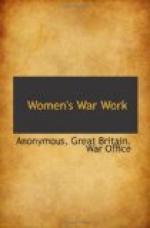The great feature of the Exhibitions was Food Saving and Conservation. Demonstrations in cooking and in hay-box cooking, were given and these were attended by thousands of women, Miss Petty, “The Pudding Lady,” being a specially attractive demonstrator. She was called “The Pudding Lady,” first by little children in London in the East End, where she used to go into the homes, and show them how to cook on their own fires, and with their own meagre possessions. When she came there was pudding, so her title came as a result.
We always included exhibits and posters on the care of the babies and the children. Lectures on vegetable and potato growing, bee and poultry keeping, etc., were also given.
There were competitions in connection with the Exhibitions—prizes were offered for the best cake—for the best war bread—for the best dinners for a family at a small cost—for the best weekly budgets of different small incomes—for the best blouse and dress made at a small cost, etc., and these were extremely popular. The prizes were generally War Savings Certificates or labour-saving devices.
From the Governmental point of view the Food work is in two great divisions: Food Production, which is worked by the Food Production Department of the Board of Agriculture, of which the Women’s Branch is doing the work of placing women on the land. It not only works on the production of more food but it organizes the conservation of food, such as fruit bottling, and preserving fruit, and vegetable and fruit drying, etc.




